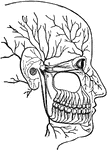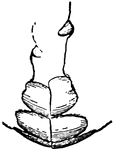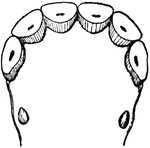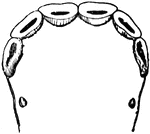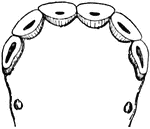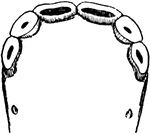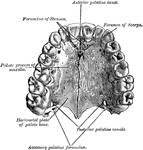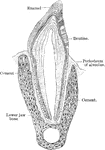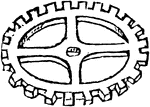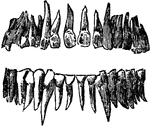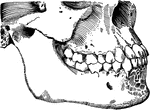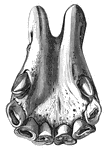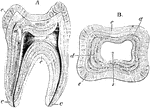
Structure of a Molar
Longitudinal section (A) and transverse section (B) of a human molar tooth. Labels: c, cement; d, dentine;…
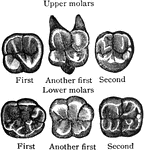
Surface of Molar
Triturating surfaces of molar teeth of right side. The upper margin of the figures corresponds to the…

Temporary Molar
Temporary molar teeth (A, first; B, second) of left side. Triturating surfaces of crowns also shown.

Vertical Section of a Molar
Vertical section of a molar tooth. Labels: a, enamel of the crown, the line of which indicate the arrangement…

Mouth Showing Palate and Tonsils
Open mouth showing palate and tonsils. It also shows the two palatine arches, and the pharyngeal isthmus…
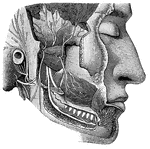
Cranial Nerves
"Dental Branch of One of the Divisions of the Fifth Pair of Cranial Nerves, supplying the Lower Teeth.…
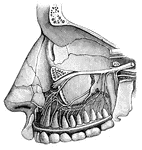
Cranial Nerves
"Dental Branches of One of the Divisions of the Fifth Pair of Cranial Nerves, supply the Upper Teeth."…
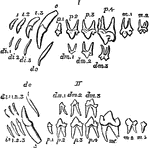
Permanent Dentition
"Milkand permanent dentition of upper (I) and lower (II) jaw of the dog, with the symbols by which the…
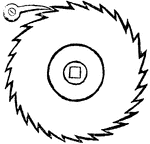
Ratchet-wheel
"A circular wheel, with teeth on the circumference, by which it can be moved or its motion stayed."…
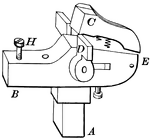
Saw Set for a Work Bench
"a. shank for fixing the implement to a bench; c. punch, hinged to a base b and e; and pressed upward…

Collection of Saw-Sets
A saw-set is an "instrument used to wrest or turn the teeth of saws alternately to the right left so…
Sawfish, Side View
Pristis pectinatus. "1. An elasmobranchiate or selachian fish of the family Pristidae, having the snout…
Sawfish, View from Underneath
Pristis pectinatus. "1. An elasmobranchiate or selachian fish of the family Pristidae, having the snout…
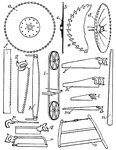
Collection of Saws
This illustration includes numerous types of saws: a. Circular saw (right-hand and left-hand saws have…
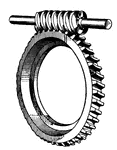
Screw-and-Worm Gearing
Screw-and-Worm gearing is a type of gearing in which the velocity ratio is independent of the radii…
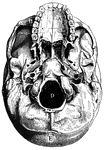
Base of skull
"A, Palate process of upper jawbone; B, zygoma, forming zygomatic arch; C, condyle, for forming articulation…

Base of the Skull
The base of the skull. "The lower jaw has been removed. At the lower part of the figure is the hard…

Dogtooth Spar
"...a variety of calcite, crystallizing in scalenohedral forms; so named from a fancied resemblance…
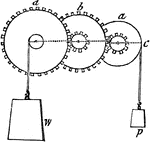
System of Wheels
"System of Wheels.—As the wheel and axle is only a modification of the simple lever, so a system…
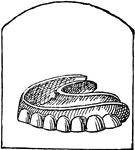
Teeth
The series of small bones attached to the jaws of animals, or human beings, which serve the purpose…

Teeth
The hard, bony structures situated in the mouth or near the entrance to the pharynx of vertebrates,…

Teeth
To show the relation of the upper to the lower teeth when the mouth is closed. The manner in which a…
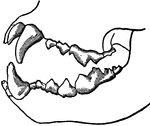
Teeth of a Carnivorous Animal
Teeth of a carnivorous animal that lives on flesh alone. The front teeth are designed for tearing, while…

Teeth of a Child
Temporary teeth in a child aged about 4 years. The permanent teeth are seen in the process of formation…
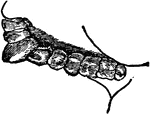
Teeth of a Frugivore
Teeth of a frugivore (fruit-eating animal). Animals that live on soft fruits do not need such grinders…

Teeth of an Herbivore
Teeth of an herbivore, showing the rough surface of some of these teeth. Herbivores have no tearing…

Comparing Teeth of Carnivora and Insectivora Animals
The image on the left are the teeth of a carnivora or flesh-eating animal. The teeth on the right belong…

Teeth of Man and Several Animal Species
1. Dentition (teeth) of man. 2. Dentition of hyena. 3. Dentition of pig. 4. Dentition of Patagonian…

Teeth of the Upper Jaw
Half of the teeth of the upper jaw. a,a, are the two front cutting teeth. d,d,d are…

The Adult Teeth
The adult teeth. Labels: 1, 2, The cutting teeth (incisors). 3, Eyetooth (cuspid). 4,5, Small grinders…
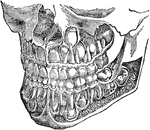
The Deciduous and Permanent Teeth
The deciduous and permanent teeth, shown as they are placed in the jaw with portions of bone removed…

Development of Teeth
The first step in the development of teeth consists in a downward growth from the Rete Malpighi or the…
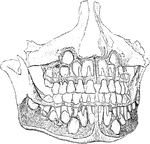
Development of Permanent Teeth
Well formed jaws, from which the alveolar plate has been removed to expose the developing permanent…
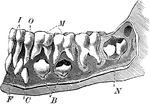
Emergence of Adult Teeth
The teeth of a 6 and a half year old child. Label: I, the incisors; O, the canine; M, the molars; the…
!["A Tooth is one of the hard bodies of the mouth, attached to the skeleton, but not forming part of it and developed from the dermis or true skin. True teeth consist of one, two, or more tissues differing in their chemical composition and in their microscopical appearances. Dentine, which forms the body of the tooth, and 'cement,' which forms its outer crust, are always present, the third tissue, the 'enamel,' when present, being situated between the dentine and cement. The incisors, or cutting teeth, are situated in front. In men there are two of these incisors in each side of each jaw. The permanent incisors, molars, and premolars are preceded by a set of deciduous or milk teeth, which are lost before maturity, and replaced by the permanent ones. The canines come next to the incisors. In man there is one canine tooth in each half-jaw. The premolars (known also as bicuspids and false molars) come next in order to the canines. In man there are two premolars in each half-jaw. The true molars (or multicuspids) are placed most posteriorly. In man there are three molars in each half-jaw, the posterior one being termed the wisdom tooth. The figures [in the illustration] refer to months after birth."—(Charles Leonard-Stuart, 1911)](https://etc.usf.edu/clipart/15200/15256/teeth1_15256_mth.gif)
First Teeth
"A Tooth is one of the hard bodies of the mouth, attached to the skeleton, but not forming part of it…



